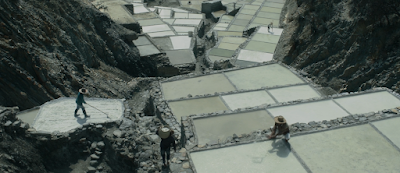Alfonso Cuarón director: Remember what Claude Chabrol said: ‘There is no wave, there is only the ocean.’ I am not purely interested in ‘Mexican cinema’, I am interested in cinema. And when you start using these words like ‘wave’, it’s a way of creating an identity for certain films, but it also becomes an aspect of marketing. You know, the common identity of the films people are describing as part of this ‘Mexican wave’ is that they are cinema. And that is the reason these films are seen everywhere and why they have been embraced everywhere. But people are also disregarding Mexican film-makers who have been making films for the last thirty years - people like Arturo Ripstein. You have to remember that there have been lots of Mexican film directors, but that doesn’t make a ‘wave’ - it’s not as if we have all shared a particular aesthetic. Quote 1
When I stumbled across three Mexican films,
Amores Perros,
Y tu mamá también and
The Devil’s Backbone, in quick succession sometime in 2001, I never considered the films as part of a “New Wave of Mexican Cinema”. The trio were completely different films that just happened to come out of Mexico. But I can imagine that it was a convenient tag to help classify things. For example, recently after three films from Romania (
The Death of Mr. Lazarescu,
12:08 East of Bucharest &
4 Months 3 Weeks 2 Days) made a splash on the film festival circuit in successive years, the media immediately called it the “New Romanian wave”. Three films is still too early to label a movement, plus there is no reason to believe the Romanian film directors were collaborating together for a conscious movement. Even though Alfonso Cuarón, Guillermo del Toro and Alejandro González Iñárritu are friends who have either helped edit or given helpful suggestions to each other's works, they are still three independent directors who are making high quality cinema yet they were/are lumped together under one label.
Hugo Rodriguez director: Let’s not forget that Mexico has a long film-making tradition, which started almost at the same time as the international film industry was born. We have films that date back to the early 1900s, and the historical relationship with Hollywood has meant that our technicians are highly trained. Quote 2
Thankfully old Mexican films are being made available in North America via new DVD releases and it will certainly help in getting a feel for Mexico’s rich cinematic history.
But taking a look from the early days of Mexican cinema...
1) The 1930's plus the Revolution period
Fernando de Fuentes began his career as a cinema manager, and would later use his experience in this regard to challenge the existing exhibition monopoly of the 1940s. He became arguably the most important figure in the Mexican cinema of the 1930s because his trilogy of films about the Revolution: El prisionere trece (1933), El compadre Mendoza (1933) and Vamonos con Pancho Villa (1934). Quote 3
I have only seen
El compadre Mendoza of Fernando de Fuentes’s works and it is an engaging film that beautifully integrates a friendship tale with the complicated dynamics of a revolution. In a way, the talk of revolution is deeply associated with the image of Mexico. Even a film like
Ocean’s Thirteen couldn’t resist stoking the fire of revolution in a Mexican setting. In a humorous segment of
Ocean’s Thirteen, the ‘twins’ are sent to a Mexican dice making plant but they end up stirring things up over Tequila and talk of Zapata resulting in the workers shutting the plant down.
2) The Golden Age of Mexican Cinema or ‘El Cine de Oro’ -- 1940’s through to 60’s
Luis Buñuel’s Mexican films fall within this time period as well.
Emerging at the tail end of ‘Cine de Oro’ period, the director [Buñuel] arguably provides a lineage with the subsequent ‘Grupo Nuevo Cine’, and - through his unsentimental consideration of themes of poverty and social injustice, allied with his formal experimentation and ability to work creatively with limited resources -- to the prominent Mexican directors who would emerge on the cusp of the twenty-first century. Quote 4
3) The Re-emergence plus ties with Hollywood
Mexican cinema seems to have suffered in the late 1970’s and early 80’s. But near the end of the 80’s and start of the 1990's, Mexican cinema regained its footing with renewed vigor.
After years of drought, the early 1990s witnessed the feature-film debuts of several directors who would thereafter become international names. A new generation was on the brink of making itself heard, and these directors were conscious that something of a break from the past would be necessary if they were to assert their own identities. Quote 5
Some of the more famous directors whose names are associated with the re-emergence in the early 1990’s are Carlos Carrera, Alfonso Cuarón and Alfonso Arau.
Alfonso Arau’s
Like Water for Chocolate (
Como agua para chocolate) made international headlines and also gave Mexican culture plenty of attention as well considering the story focuses on the richness of Mexican food. In fact,
Like Water for Chocolate was probably the first Mexican film I ever saw in my life. I had enjoyed reading the sensual novel and was drawn to the film to see how much of the passion could be recreated. After gaining success on the home front, Arau next ventured to Hollywood for
A Walk in the Clouds.
The geographical closeness to America certainly enabled a lot of movement between Mexican cinema and Hollywood for some directors. Even though Alfonso Cuarón made his cinematic start with the Mexican film
Love in the Time of Hysteria, he moved across the border to direct
The Little Princess and
Great Expectations. I first caught up with Cuarón's work with the visually imaginative
Great Expectations, a film that I lined up to see on opening day back in January 1998. The film was a bit of a let down but the soundtrack was mesmerizing and the visuals completely alluring.
Guillermo del Toro has also moved successfully back and worth between Mexico and USA. It appears that after making a commercial Hollywood film, he returns back to Mexico to create a powerful Spanish language film. After making his feature film debut with
Cronos in 1993 he ventured to Hollywood with
Mimic before returning for
The Devil’s Backbone followed by enjoyable comic book ventures in
Blade 2 and
Hellboy before his award winning
Pan’s Labyrinth. And this year, del Toro was behind the second installment of
Hellboy II: The Golden Army
And then there is the case of Robert Rodriguez. Born in the U.S, he traveled to Mexico to shoot his now famous
El Mariachi on a shoe-string budget before returning to Hollywood for a sequel of sorts with the stunning
Desperado. And the Antonio Banderas guitar swinging gun fighting film also introduced North American audiences to the seductive Salma Hayek. Rodriguez has been prominent in Hollywood since 1995 but he did pay a brief ode to Mexico in 2003 with the final chapter in his Mariachi trilogy
Once Upon a Time in Mexico, a film with some charm but still in need for more chopping.
The Mexican tie with Hollywood certainly got more attention in 2007 when the films
Children of Men (Alfonso Cuarón),
Pan’s Labyrinth (Guillermo del Toro ) and
Babel (Alejandro González Iñárritu) were earning spots in critics year end best film lists.
4) 2000 onwards: New faces and new visions
Carlos Reygadas arrived on the international film festival circuit with his visually stunning
Japon in 2002. Reygadas has certainly added a different flavour to the vision of Mexico from that presented by Cuarón, Guillermo del Toro and Alejandro González Iñárritu. Reygadas has shown a different side of Mexico in his films, like featuring the peaceful countryside in
Japon, the rich Mexican suburbs in
Battle in Heaven or a German Mennonite community in
Silent Light. Carlos also has had a prominent influence on Amat Escalante and helped produce Escalante’s debut film
Sangre in 2005. I came across
Sangre at the London Film Festival back in 2005 and unfortunately I happened to see the film at the wrong time in my cinematic journey. While I loved some sequences of
Sangre (some scenes that have still stayed with me, like the shot of the garbage landfill), I was not that impressed with the film. Now, after having seen Reygadas’
Battle in Heaven I can fully appreciate
Sangre as both films form a worthy double bill and present a fresh look into Mexican life from the eyes of characters who would hardly grace the camera of most film productions.
While talking about Iñárritu’s three features, one can’t ignore the writing talents of Guillermo Arriaga. It is unfortunate to read that Iñárritu and Arriaga won’t collaborate on further films but Arriaga’s writing style manages to beautifully capture the essence of Mexican life. I have enjoyed reading his two novels
A Sweet Smell of Death and
The Night Buffalo while Arriaga’s moving script for
The Three Burials of Melquiades Estrada captures the tender complications of moving across the US border to start a new life.
Some other interesting Mexican films that I have seen in the last two years such as
Used Parts (Aarón Fernández Lesur),
Drama/Mex (Gerardo Naranjo) and
Bad Habits (Simón Bross) suggest that there is indeed a positive future for Mexican films, beyond the works of the well known directors.
Films chosen as part of Spotlight
I wanted to pick a film from each major time period of Mexico’s cinematic journey and in that regard I came across the following five titles:
The Woman of the Port (1934, Arcady Boytler/Raphael J. Sevilla): 7.5/10
Aventurera (1950, Alberto Gout): 7/10
A Woman Without love (1952, Luis Buñuel): 8/10
The Skeleton of Mrs. Morales (1960, Rogelio A. González): 9/10
No One Writes to the Colonel (1999, Arturo Ripstein): 6/10
Instead of picking the well known Mexican films by Buñuel, I opted for
A Woman Without Love. While the love affair story may not be that ground breaking but Buñuel’s direction ensures that the film does not become too melodramatic and instead conveys a compassionate tale of sacrifices that true love has to endure.
Both the leading women in
The Woman of the Port and
Aventurera find themselves forced into prostitution due to circumstances. In
The Woman of the Port, Rosia turns to the trade after her cheating lover kills her father. But the film saves a nasty twist in the end, something that sheds an even darker light on an already tragic tale. In
Aventurera, Elena is forced into prostitution after her dreams of a better life in the big city are shattered by a trusted family friend. But Elena discovers her inner strength and is able to extract revenge, albeit by playing an emotional game of chess.
The most disappointing film turned out to be Arturo Ripstein’s
No One Writes to the Colonel, a film based on Gabriel Garcia Marquez’s novel. On the flip-side, the true gem of the lot turned out to be
The Skeleton of Mrs. Morales, a wicked dark comedy with a delicious twist in the end. The film features plenty of imaginative camera angles, combined with a very witty story that does not shy from dragging its characters through the mud.
Reference for all quotes used:
The Faber book of Mexican cinema by Jason Wood.





























